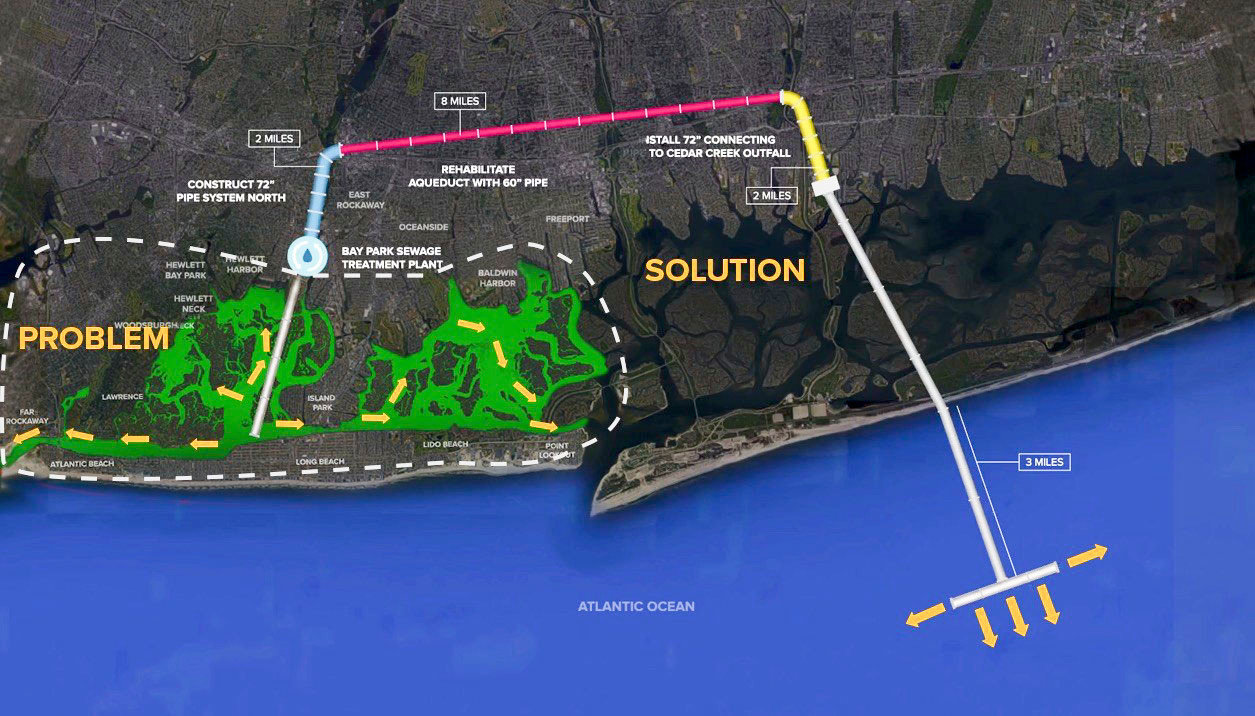County Legislature OKs $408 million for plan to re-route treated sewage from Bay Park to Wantagh
A long-awaited project to remove nitrogen from the Western Bays gained steam on Sept. 9, when the Nassau County Legislature unanimously voted to borrow $408 million to build a system to divert treated sewage from Bay Park to Wantagh, and from there into the Atlantic Ocean.
When it is completed, the Bay Park Conveyance Project will send treated wastewater from the Bay Park Water Reclamation Facility to an ocean outfall pipe at the Cedar Creek Water Pollution Control Plant in Wantagh, using a 100-year-old aqueduct beneath Sunrise Highway.
Gov. Andrew Cuomo announced the project in 2017, to eliminate the discharge of wastewater into Reynolds Channel through an outfall pipe just north of the Long Beach fishing pier. Wastewater will instead be piped three miles from the Cedar Creek plant into the Atlantic.
“The Bay Park Conveyance Project will help prevent the major source of nitrogen pollution from degrading marsh islands and damaging the delicate ecosystem that helps protect Long Island’s coast from devastating waves and storm surges,” Cuomo said. “New York’s innovative efforts to improve our infrastructure will be instrumental in protecting water quality and will support stronger, more resilient communities that are prepared to withstand extreme weather.”
The plan will end the discharge of an estimated 19 billion gallons of treated wastewater into the Western Bays each year, which will help rejuvenate marshlands that are vital to protecting coastal communities from storm damage.
The Bay Park plant, built in 1941, serves 500,000 residents, discharging an average of 52 million gallons of treated effluent into Reynolds Channel per day. Nitrogen from the wastewater impacts nearly 10,000 acres of water and tidal marshland in the Western Bays, from Atlantic Beach to Point Lookout. One major focus of the project is to enable the ecological recovery of the bays in a timely and cost-efficient manner. Building a new outfall pipe would have cost $600 million and taken a decade, officials said.
The project includes building a two-mile, 72-inch force main north from the Bay Park plant to the county-owned aqueduct that runs under Sunrise Highway; rehabilitating an eight-mile stretch of the aqueduct by removing 14 gate valves and lining the 72-inch abandoned main; and constructing a two-mile, 72-inch force main from the aqueduct to the existing Cedar Creek outfall pipe, which is 6.5 miles long. The new force main segments will be constructed using micro-tunneling 20 to 50 feet below ground, officials said.
The plan is to pump the treated wastewater from Bay Park through the two underground tunnels to the aqueduct, and then to the outflow pipe in Wantagh. The Cedar Creek plant’s outfall pipe extends about three miles into the Atlantic Ocean to a one-mile-long diffusion pipe, and can take on a maximum flow of 200 million gallons of effluent per day.
The project is estimated to cost between $460 million and $480 million, and the state has committed to spending $73 million to help offset the cost, while the federal government will contribute $77 million. County officials approved the bonding, 18-0, in an emergency vote while facing a Sept. 13 deadline to apply for grant funding.
A ‘crucial’ project
County Executive Laura Curran said it was crucial to secure funding to help cleanse the Western Bays. “I am pleased that we are steadily moving along with the crucial Bay Park project,” she said, “which upon completion will result in cleaner water, a healthier environment, and more resilient coastal communities on Nassau’s South Shore.”
In addition to the bond resolution, county officials also approved a contract with a program management firm to help the state and county expand the project. The program manager will work with the state to oversee the project’s design and construction. The contract will undergo further county and state reviews before it is executed.
“With county bond funding approved, and a qualified and committed team coming together to expedite this critical project, we are another step closer to restoring the health and resiliency of Nassau County’s Western Bays,” said Basil Seggos, commissioner of the state Department of Environmental Conservation.
The $408 million will be added to an $830 million state and federal investment to rebuild the Bay Park plant. On Oct. 29, 2012, at the height of Hurricane Sandy, a nine-foot tidal surge hit the facility, causing catastrophic damage to the plant and its infrastructure. Seawater inundated many parts of the plant, submerging critical pieces of equipment and rendering them inoperable.
In the years since, efforts have been made to revitalize the plant and make it more storm-resilient. The ongoing project includes the repair and upgrade of numerous treatment and collection systems and pump stations, and the installation of engineered structures to protect the plant from a potential storm more powerful than Sandy. The county is also installing two nitrogen treatment systems at the facility to reduce nitrogen concentrations in treated wastewater by up to 50 percent.
After the approval of the funding, Town of Hempstead Supervisor Laura Gillen said it is vital to restore the marshland. “Flooding is a significant risk for homeowners and small businesses in the Town of Hempstead,” she said. “We need to constantly build safer, stronger and smarter, which includes re-establishing critically important marshland to absorb water and protect our coastal communities from tidal surges and major storm events.”

 45.0°,
Partly Cloudy
45.0°,
Partly Cloudy 




